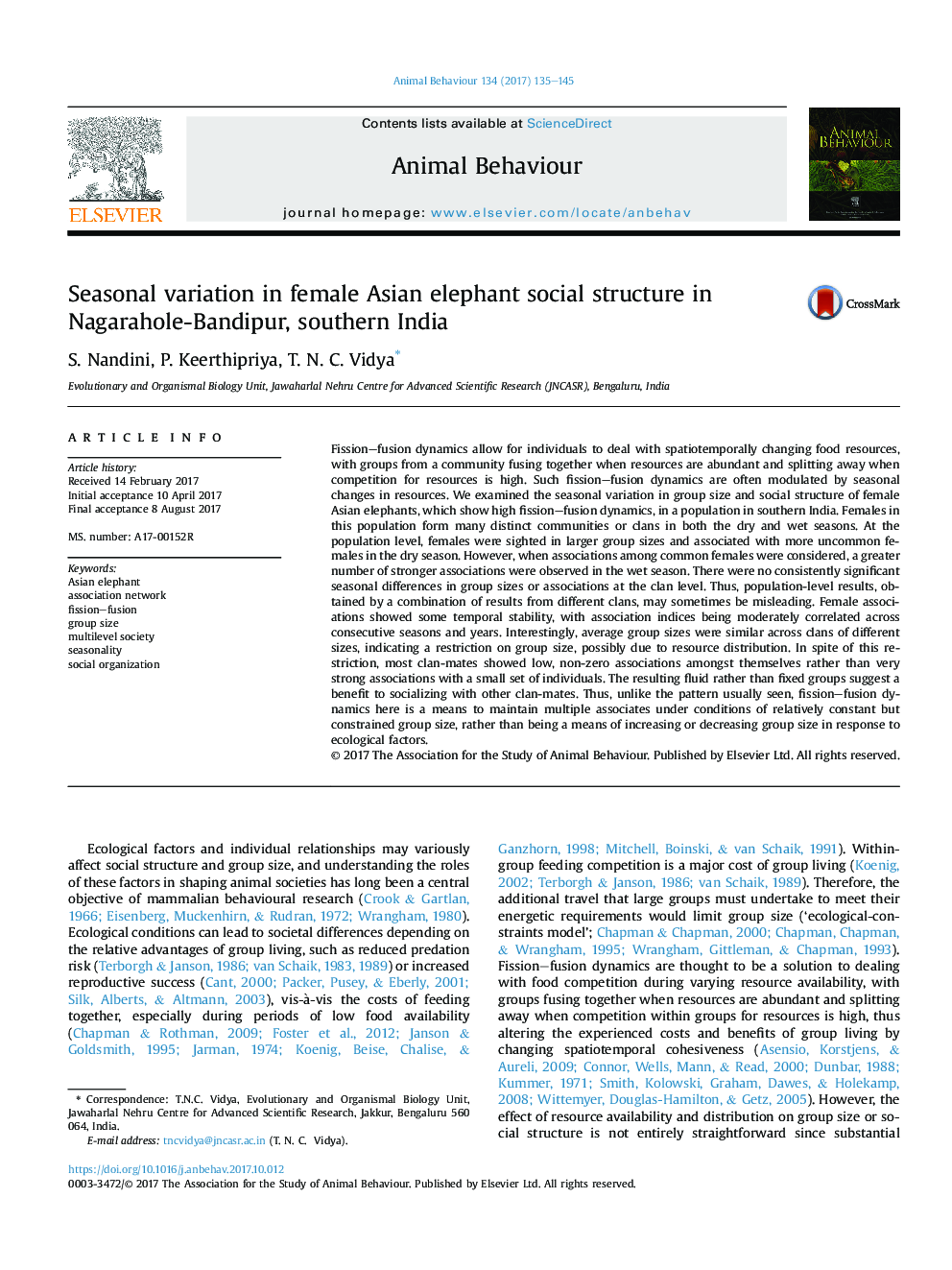| کد مقاله | کد نشریه | سال انتشار | مقاله انگلیسی | نسخه تمام متن |
|---|---|---|---|---|
| 8488790 | 1552194 | 2017 | 11 صفحه PDF | دانلود رایگان |
عنوان انگلیسی مقاله ISI
Seasonal variation in female Asian elephant social structure in Nagarahole-Bandipur, southern India
ترجمه فارسی عنوان
تنوع فصلی در ساختار اجتماعی زن فیل آسیایی در ناگاراهول-بندپیور، جنوب هند
دانلود مقاله + سفارش ترجمه
دانلود مقاله ISI انگلیسی
رایگان برای ایرانیان
کلمات کلیدی
ترجمه چکیده
پویایی تقسیم جوش امکان دارد افراد برای مقابله با تغییرات فضایی تغییرات مواد غذایی، با گروه هایی از یک اجتماع که با هم مخلوط شوند، وقتی که منابع فراوان هستند و زمانی که رقابت برای منابع زیاد است، تقسیم می شود. چنین پویایی تقارب تقاربی اغلب توسط تغییرات فصلی در منابع تغییر می یابد. ما تغییرات فصلی در اندازه گروه و ساختار اجتماعی فیلهای زن آسیایی را، که نشان می دهد پویایی تقسیم با تقسیم بالا، در جمعیت در جنوب هند، مورد بررسی قرار دادیم. زنان در این جمعیت، جوامع یا قبیله های متمایز را در فصل های خشک و مرطوب تشکیل می دهند. در سطح جمعیت، زنان در گروه های بزرگتر دیده شده و با زنان غیر معمول در فصل خشک مرتبط بودند. با این حال، زمانی که ارتباط بین زنان معمولی در نظر گرفته شد، تعداد بیشتری از انجمن های قوی تر در فصل خیس مشاهده شد. تفاوت های فصلی در اندازه های گروهی یا انجمن ها در سطح قبیله به طور قابل توجهی وجود نداشت. بنابراین، نتایج جمعیتی که توسط ترکیبی از نتایج قبایل مختلف به دست می آید ممکن است گمراه کننده باشد. انجمن های زنانه برخی از ثبات زمانی را نشان دادند و شاخص های همبستگی در طول فصل و سال های متوالی همبستگی داشتند. جالب توجه است که میانگین گروه ها در کلان های مختلف اندازه مشابه بودند، که نشان دهنده محدودیت در اندازه گروه است، احتمالا به دلیل توزیع منابع. به رغم این محدودیت، اکثر پیروان خاندان کمترین و غیر صفر در میان خودشان، نسبت به ارتباطات بسیار قوی با مجموعه کوچکی از افراد، نشان دادند. مایع منجر به جای گروه های ثابت، منافعی برای برقراری ارتباط با دیگر قبیله ها می دهد. بنابراین، بر خلاف الگوی معمول دیده می شود، پویایی تقسیم-همجوشی در اینجا یک وسیله برای حفظ همتایان چندگانه در شرایط نسبتا ثابت، اما محدود به اندازه گروه است، به جای اینکه به معنای افزایش یا کاهش اندازه گروه در پاسخ به عوامل محیطی باشد.
موضوعات مرتبط
علوم زیستی و بیوفناوری
علوم کشاورزی و بیولوژیک
علوم دامی و جانورشناسی
چکیده انگلیسی
Fission-fusion dynamics allow for individuals to deal with spatiotemporally changing food resources, with groups from a community fusing together when resources are abundant and splitting away when competition for resources is high. Such fission-fusion dynamics are often modulated by seasonal changes in resources. We examined the seasonal variation in group size and social structure of female Asian elephants, which show high fission-fusion dynamics, in a population in southern India. Females in this population form many distinct communities or clans in both the dry and wet seasons. At the population level, females were sighted in larger group sizes and associated with more uncommon females in the dry season. However, when associations among common females were considered, a greater number of stronger associations were observed in the wet season. There were no consistently significant seasonal differences in group sizes or associations at the clan level. Thus, population-level results, obtained by a combination of results from different clans, may sometimes be misleading. Female associations showed some temporal stability, with association indices being moderately correlated across consecutive seasons and years. Interestingly, average group sizes were similar across clans of different sizes, indicating a restriction on group size, possibly due to resource distribution. In spite of this restriction, most clan-mates showed low, non-zero associations amongst themselves rather than very strong associations with a small set of individuals. The resulting fluid rather than fixed groups suggest a benefit to socializing with other clan-mates. Thus, unlike the pattern usually seen, fission-fusion dynamics here is a means to maintain multiple associates under conditions of relatively constant but constrained group size, rather than being a means of increasing or decreasing group size in response to ecological factors.
ناشر
Database: Elsevier - ScienceDirect (ساینس دایرکت)
Journal: Animal Behaviour - Volume 134, December 2017, Pages 135-145
Journal: Animal Behaviour - Volume 134, December 2017, Pages 135-145
نویسندگان
S. Nandini, P. Keerthipriya, T.N.C. Vidya,
